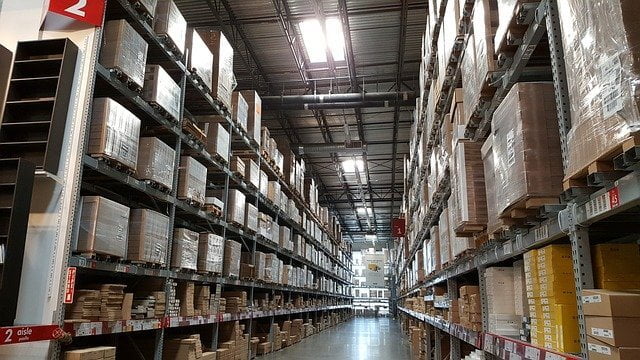The logistics industry is in a period of unprecedented demand. With eCommerce and the pandemic testing supply chains to their limits, businesses of all kinds will continue to experience tremendous pressure to refine their operations and deploy innovative technologies in the next several years.
What are the tech innovations that will allow entrepreneurs to compete and thrive in these difficult times? Ahead, we’ll examine five big trends in the ways that businesses are unlocking the future of logistics in their warehouse operations.

RFID technologies will gain market share in inventory management.
Radiofrequency identification (RFID) is a technology with potentially massive benefits for warehouse inventory management. Using a transponder housed in a plastic project box with a battery, businesses can use unique radio frequency signals to identify items quickly and accurately.
RFID has several major advantages over traditional barcode inventory systems. An RFID transponder system can read multiple tags at once, replacing the labor-intensive one-by-one scanning required in barcode systems. RFID systems also present opportunities for automation because many of these systems can automatically scan items as they pass through warehouse touchpoints.
Some hurdles remain for RFID to clear, including the technology’s difficulty with penetrating liquids and metal surfaces. Solutions such as the use of polycarbonate enclosures for warehouse technologies (rather than metal) can alleviate these problems, but it underscores the need for businesses to design multiple aspects of their facilities around new technologies rather than simply forcing them into existing molds.

IoT will make warehouses more connected and easier to monitor.
The Internet of Things (IoT) has numerous industrial use cases that can improve efficiency and connectivity in the warehouse. Industrial IoT sensors are able to monitor anything from stock levels to temperature and humidity, making it simple both to collect KPI data and to identify circumstances that require intervention.
As the popularity of warehouse IoT increases, many businesses are taking their first steps by identifying key points that currently lack visibility and targeting them with IoT solutions. For example, a company suffering from repeated breakage of goods may deploy smart kinetic sensors in its packaging to identify where and when breakage is occurring.
Much like RFID systems, warehouse IoT will also require a commitment to retooling existing systems for optimal compatibility, not simply plugging in an IoT technology and expecting results. In addition, businesses will need to be aware of the security risks that any IoT technology presents and proactively implement security features that protect their IoT networks from unauthorized access.
The role of predictive analytics will evolve to strengthen supply chains in new ways.
Predictive analytics has become a major element of many businesses’ supply chains, but their role will undoubtedly change in the post-pandemic world. With supply chains constantly being rocked by unpredictable market conditions, “the past is no longer a guide to the future,” as one MIT expert puts it. That phenomenon will likely create a paradigm shift in how warehouses and supply chain managers use data to make decisions.
For one thing, the business world is already moving away from the “just in time” model that has been a fundamental part of predictive analytics in the past 20 years. Rather than using predictive analytics to cut warehouse stocks to the bone, forward-thinking businesses are using it to design supply chains that serve markets and communities more efficiently and effectively. This means embracing new types of data and implementing new measures to help supply chains be prepared.
External data is now key for understanding the wild world in which 21st century supply chains operate. Today, that might be COVID case numbers, but some businesses are already expanding it to include factors like climate change. That, in turn, will be important for supply chain contingency planning, which will help businesses weather the inevitable disruptions of the coming decades.
The renewable energy revolution will reach the warehouse sector.
Renewable technologies like electric vehicles are already making waves in the logistics industry, but innovations at the warehouse level will quickly gain importance in the next several years. The renewable energy revolution will have far-reaching effects on warehouses, both in terms of sustainability and the bottom line.
The price of solar technologies has plummeted in recent years, and warehouses are now taking a serious look at options such as installing rooftop solar panels. Solar panels can help reduce a warehouse’s often-substantial electricity bills, and the typical warehouse roof is well-suited for solar panel installation. Increasingly, it will look like a win-win for logistics businesses.
Others are electrifying their warehouse vehicles, as evidenced by the healthy growth forecast for the electric forklift market. Electrifying forklifts is a great way to simultaneously reduce fuel costs and dependence on fossil fuels. While the cost of setting up a charging station can be substantial, many warehouses have decided that the investment will offer good ROI in the long term.
Demand for micro-fulfillment centers will force businesses to think small.
Making ultra-fast deliveries to consumers in urban centers is a crucial goal for many logistics companies, and micro-fulfillment centers (MFCs) are emerging as an important piece of the puzzle. These urban warehouses are often responsible for serving both eCommerce orders and brick and mortar stores, but their footprint is often just a fraction of the space that a normal warehouse or DC occupies. Some are even built as attachments to existing retail stores.
Automation is a cornerstone of most successful MFC strategies. Large retailers like Walmart have invested heavily in highly automated MFCs that can efficiently pick and pack fast-moving SKUs like groceries and personal care items. Moving these items closer to the customer and automating their distribution more heavily is critical for making supply chains more agile. It also helps prepare for the swings in supply and demand that have characterized pandemic-era logistics.
For smaller businesses, on-demand MFC services are a common alternative option. These 3PL warehousing providers offer leases on MFC space in urban centers and will often hold many different businesses’ stock in a single facility. Since most small businesses don’t have easy access to the capital required to build a first-party MFC, this so-called “warehouse-as-a-service (WaaS)” model will become an increasingly important element of urban logistics in the 2020s.






